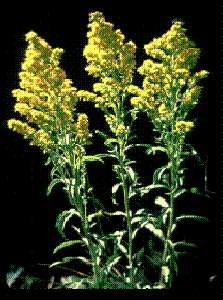Prairie Goldenrod (Solidago missouriensis)

The earliest of our goldenrods, prairie goldenrod usually begins to bloom in late July and continues through August. The plant occurs statewide. Overall, the species ranges from British Columbia to Wisconsin, south to Oregon, Arizona, and Missouri at elevations up to 10,000 ft.
Prairie goldenrod is perennial from cord-like rhizomes (horizontal roots that sprout new plants along their length). Plants stand one to two feet tall. The smooth leaves are narrow and sometimes toothed near the tip. Bright yellow flower heads crowd about a dozen arcuate branches that form a roughly triangular cluster at the top of the plant. Fruits are tiny achenes bearing bristles to aid transport by wind.
In North Dakota, this goldenrod grows best on dry native prairie where grazing is moderate or heavy. In more arid regions, plants may be more abundant where grazing is light. Many North American goldenrods have long been used for teas, foods, and medicines by the Amerindians. Prairie goldenrod is not mentioned in this regard, but likely has some of these useful properties.
Goldenrods are members of the sunflower family (Asteraceae), the largest family in North Dakota and most temperate regions of the Northern Hemisphere. Aster means "star" in Greek, in reference to the radiate arrangement of the flowers in the heads. Each tiny flower head in prairie goldenrod has about fifteen to twenty-five flowers. The generic name stems from the Latin solidus, "whole", probably in allusion to the reported properties of the goldenrods to heal wounds. The specific epithet missouriensis means "of Missouri".
![]()
![]()
Back to Plants
 Wildflower
Seed For Sale
Wildflower
Seed For Sale